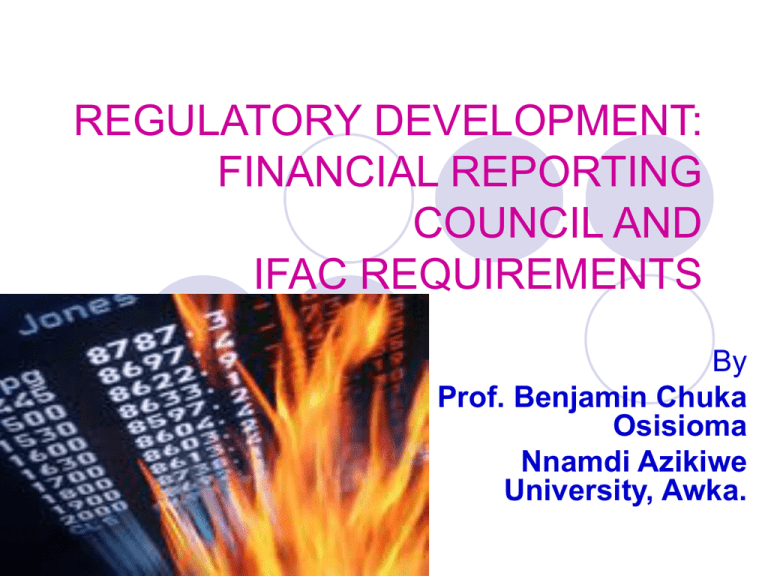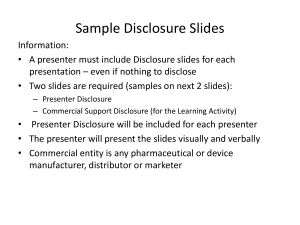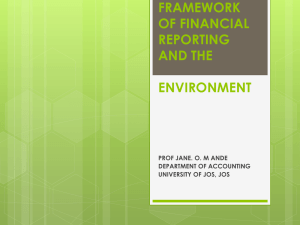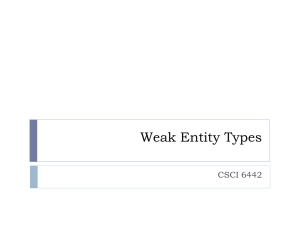regulatory development: financial reporting council and ifac
advertisement

REGULATORY DEVELOPMENT: FINANCIAL REPORTING COUNCIL AND IFAC REQUIREMENTS By Prof. Benjamin Chuka Osisioma Nnamdi Azikiwe University, Awka. I. INTRODUCTION Three major phenomena have defined the agenda for recent developments in the accounting profession: - A series of corporate misadventures and professional abuses, which began with the Enron scandal in 2001/2002; - The Asian Financial Crisis, 1997/98 fuelled largely by a ballooning currency crisis and weak financial systems; - The global financial meltdown of 2008 which started as a crash in the US mortgage industry, and soon spread to all countries of the world. Together, these crises worked transformed the regulatory and public policy environment for accounting and auditing world-wide. Perhaps the gravest consequence of these mishaps is the loss of the freedom of self-regulation which had in the past governed the development of the profession. Today, the emerging regulatory landscape is quite a crowded field encompassing – - The G20 which in April 2009 set up the Financial Stability Board to ensure global convergence of standards and their consistent application, enhanced risk disclosure, disclosure of complex financial instruments, and financial regulatory reform; - The International Forum of Independent Audit Regulators. IFIAR among other objectives sought to look into a wide range of issues - revenue recognition, professional judgement, auditor skepticism, group audits, second partner review, governance and transparency of firms, and international networks. The new emphasis is on: Mandatory rotation of auditors; Greater transparency in financial and accounting statements; Increased focus on corporate bribery, fraud and defalcation; Tightening the Scope of Services provided by accountants and auditors; Increased Oversight and Supervisory function; Enhancement in Corporate Governance practices; New Risk Management & Compensation practices; Expansion of Business Reporting; Questioning the role of the Audit Function; Increase in Mandatory Capital; Emphasis on Systemic Safety and Soundness; Call for Convergence of Standards; and, Financial Regulatory Reform. The G20 sought to ensure transparency and accountability through: -Enhanced guidance for valuation of securities; -Accounting and disclosure standards for off-balance sheet vehicles; -Required disclosure of complex financial instruments; -Governance of the international accounting standards setting body; -A single set of high-quality global standards; -Consistent application and enforcement of high-quality accounting standards; -Enhanced risk disclosures. -A single set of high-quality global standards; -Consistent application and enforcement of high-quality accounting standards; -Enhanced risk disclosures. All these factors impacted on the development of the regulatory landscape. In the United States the Blue Ribbon Committee Report released its Report in February 1999 to influence the pattern and general effectiveness of corporate governance. The Securities and Exchange Commission (SEC) unveiled a Public Accountability Board empowered to perform quality control reviews and ensure that the profession’s ethical, auditing and quality control standards are of the highest calibre. The goal was to address ethical lapses or competence deficiencies among accountants. In July 2002, the Sarbanes-Oxley (SOX) Act was signed into law with far-reaching impact for accounting practice. In the United Kingdom, the Ethics Standards Board issued a consultation paper, raising three fundamental issues: independence of auditors appointed and re-appointed on the advice of management, provision of non-audit services by auditors to clients, and the need for rotation of auditors after a certain number of years! In Nigeria, these developments have resulted in the passing into law in 2011 of the Financial Reporting Council. II FINANCIAL REPORTING COUNCIL The NASB was first set up on September 9, 1982 with the task of promoting the application of the highest standards of financial reporting in Nigeria through the development and issuance of Statements of Accounting Standards for users and preparers of financial statements, investors, commercial enterprises and regulatory agencies of government. The Board was actually conceived as a National Accounting Standard Setting body like the Financial Accounting Standards Board in the US, Accounting Standards Board in the UK, and Australian Accounting Research Foundation in Australia. ANAN had in 1990, made a strong case for a Council for Registered Public Accountants in Nigeria (CORPAN) to serve as a regulatory body for accountancy profession. The CORPAN was to be charged with: -Oversight function over the profession; -Stipulation of Code of Professional Best Practices among professional accountants in Nigeria; -Observance and enforcement of professional ethics; -Resolution of conflict in the profession; -Maintainance of discipline and good practice in the profession. In 1990, the Companies and Allied Matters Act required that financial statements prepared under the Act shall comply “... with the accounting standards laid down in the Statements of Accounting Standards issued from time to time by the Nigerian Accounting Standards Board” (Sec. 335 (1). This was a form of legal recognition for the body. In 2003 the NASB Act was formally promulgated, charging the Board with the functions to: Develop and publish Statements of Accounting Standards (SAS); Promote the general acceptance and adoption of such Standards; Promote and enforce compliance with the Standards; Review the accounting Standards from time to time Receive notices of non-compliance with the Standards; Receive copies of qualified audit reports. The Financial Reporting Council (FRC) of Nigeria Act 2011 repealed the Nigerian Accounting Standards Board (NASB) Act of 2003, and created the Financial Reporting Council whose task shall be to: Protect investors and other stakeholders interest; Give guidance on issues relating to financial reporting and corporate governance; Ensure good corporate governance practices in the public and private sectors of the Nigerian economy; Ensure accuracy and reliability of financial reports and corporate disclosures; and, Harmonize activities of relevant professional and regulatory bodies as relating to Corporate Governance and Financial Reporting. The FRC is empowered to “enforce and approve enforcement of compliance with accounting, auditing, corporate governance and financial reporting standards in Nigeria”. To this end, it is further empowered to: issue rules and guidelines for the purpose of implementing auditing and accounting standards; demand assessment of internal controls, including information system controls with independent attestation; require code of ethics for financial officers and certification of financial statements by Chief Executive Officer and Chief Financial Officer; and insist that entities provide real time disclosures on material changes in financial conditions or operations. The functions of the Council include to: Develop and publish accounting and financial reporting standards, and ensure their consistency with IFRSs; Review, promote and enforce compliance with the accounting and financial standards; Receive notices of non-compliance with approved standards; Receive and review copies of annual reports and financial statements of public interest entities, and qualified reports where necessary; Advise the Federal Government on matters relating to accounting and financial reporting standards; Maintain a register of professional accountants and other professionals engaged in the financial reporting process; Monitor compliance with the reporting requirements; Promote compliance with the adopted standards issued by the IFAC and IASB; Monitor and promote education, research and training in the fields of accounting, auditing, financial reporting and corporate governance; Specify in the Reporting Standards, minimum requirements for recognition, measurement, presentation & disclosure; Develop or adopt and keep up-to-date auditing standards and ensure consistency with Standards and pronouncements of International Auditing and Assurance Standards Board. A cursory view of the law will highlight the major pre-occupation of the legislative enactment: There are four stress areas: Financial Reporting, Auditing and Assurance, Actuarial and Valuation Standards and Corporate Governance; Among the 3 Standing Committees of the Council, there is a Technical and Oversight Committee on new issues requiring setting of standards, and convergence of local and international standard and other related matters. The Directorate of Inspection and Monitoring is established to monitor compliance with auditing, accounting, actuarial and valuation standards and guidelines approved by the Council. Protection of investors, accountants, users, auditors, employers, and every other corporate stakeholder; Emphasis on the loss of self-regulation which had been the pride of the profession for centuries. The FRC is thus empowered to develop and publish, promote and enforce compliance, monitor and receive notices of non-compliance with required standards, and maintain a register of professionals involved in financial reporting. III REQUIREMENTS OF IFAC AND THE FRC. The mission of the International Federation of Accountants (IFAC) is to serve the public interest, strengthen the worldwide accountancy profession and contribute to the development of strong international economies by establishing and promoting adherence to high quality professional standards, furthering the international convergence of such standards and speaking out on public interest issues where the profession’s expertise is most relevant. The FRC Act duly acknowledges the need for convergence of the national Standards with International prescriptions. Sections 23-27 of the Act spell out the standard-setting functions of the Council in respect of Private Sector Accounting, Public Sector Accounting, Auditing Practices, Actuarial and Valuation matters. The law encourages the establishment of ethical standards particularly, for the auditor, “in relation to the independence, objectivity and integrity” of the professional. The law requires the professional accountant registered to express clear written opinion with respect to: Whether or not the financial statement as a whole give a true and fair view; Whether or not the financial statements comply with the provisions of the Act and other relevant enactments; Level of compliance with Standards issued by the Council; Level of compliance with the Code of Corporate Governance. The Council shall specify in those standards, the minimum requirements for recognition, measurement, presentation and disclosure in financial statements or other financial reports prepared by public interest entity. The IFRSs make very clear prescriptions in these areas for the guidance of national standards-setting bodies. The overarching goal is to make international comparisons of company financial statements as easy as possible. Essentially, IFRS seeks to: Synchronize accounting standards across the globe; Enhance international comparison of company financial statements; Make interpretation of company financial statements as uncomplicated and painless as possible, regardless of the country of origin or jurisdiction of the reporting entity. The IFRS Framework for the Preparation of Financial Statement states: Objectives of Financial Statements - to provide information about the financial position (balance sheet), performance (income statement) and changes in financial position (cash flow statement). The statements should also show the results of management’s stewardship, providing information about the entity’s assets, liabilities, equity, income and expenses, including gains and losses, contributions by and distributions to owners in their capacity as owners, and cash flows. Qualitative Characteristics comprising Understandability, Relevance, Reliability and Comparability. The underlying assumptions are the accrual basis and the going-concern concept. Constraints on relevance and reliability are stated as Timeliness and Benefit versus Cost. Providers of information are expected to balance the qualitative characteristics in such a way that best meets the objectives of financial statements. Elements of Financial Statement include Assets, Liabilities, Equity, Income and Expenses. Assets are resources controlled by an entity as a result of past events and from which future economic benefits or service potential are expected to flow to the entity. Liabilities are present obligations of the entity arising from past events, the settlement of which is expected to result in an outflow from the entity of resources embodying economic benefits or service potentials. Net asset/equity is the residual interest in the assets of the entity after deducting all its liabilities. Revenue is the gross inflow of economic benefits or service potential during the reporting period when those inflows result in an increase in net asset/equity, other than increases relating to contributions from owners. Expenses are decreases in economic benefits or service potential during the reporting period in the form of outflows or consumption of assets or incurrence of liabilities that result in decreases in net assets/equity, other than those relating to distribution to owners. Recognition of Elements - An element can only be recognised in the financial statements if it is probable that any future economic benefit associated with the item will flow to or from the entity; and if the item has a cost or value that can be measured with reliability. Revenue is recognised when an entity has transferred significant risk and reward of ownership to the buyer, coinciding with the transfer of the legal title or the passing of possession to the buyer. But where the entity retains significant risk of ownership, the transaction is not a sale, and revenue is not recognised. Thus, the entity retains the risk of ownership, and so there is no revenue recognition where: -the entity retains the obligation for unsatisfactory performance; -the receipt of the revenue is contingent on derivation of revenue by the buyer, as in Sale or Return transactions; -the goods are shipped subject to installation, and this is a crucial part of the contract which has not yet been completed; -the buyer has the right to rescind the purchase for a reason specified in the sales contract and the entity is uncertain about probability of return. Measurement of Elements - The following bases are used: Historical Cost, Current Cost, Realizable (settlement) Value, and Present Value (Fair market value). Fair value is to be used in measurement of financial instruments, but is optional valuing property, plant and equipment. When goods or services are exchanged or swapped for goods or services which are of a similar nature and value, no sale has occurred and no revenue is recognised. But where the goods and services are dissimilar, the exchange could be regarded as a sale. And revenue is measured at the fair value of goods and services received. Emphasis is on measuring the fair value of assets and liabilities. -Analyze the properties, strengths & weaknesses of various measurement attributes; -Provide definitions of the terms used; -Distinguish between a measurement technique and a measurement attribute; -Provide guidance for choosing a measurement attribute. Concept of Capital Maintenance include: Financial capital which is synonymous with net assets or equity and defined in terms of nominal monetary units. Profit represents the increase in nominal money capital over the period; Physical Capital which is regarded as the operating capability defined in terms of productive capacity. Profit represents the increase in productive capacity over the period. The Framework defines: Transparency as making information on existing conditions, decisions and actions accessible, visible and understandable to all; Disclosure as providing information and making policy decisions known through timely dissemination and openness. Accountability as the need for market participants to justify their actions and policies and to accept responsibility for both decisions and results. Any entity claiming compliance with IFRSs must comply with all standards and interpretations, including disclosure requirements, and make a statement of explicit and unreserved compliance; IFRSs do not apply to items that are not ‘material’; transactions are accounted for in accordance with their substance rather than their legal form. Transactions with shareholders in their capacity as shareholders are recognised directly in equity; Comparative information is required for the preceding period only, but when an entity restates comparative information following a change in accounting policy, a correction of an error or a reclassification of items in the financial statement, a Statement of Financial Position as at the beginning of the earliest comparative period is presented. Comparative information must include numerical information in respect of the previous period, and relevant narrative and descriptive information. The Statement of Comprehensive Income should cover: Revenue, Finance Costs, Share of Profits or Losses of associates or joint ventures, tax expense, Discontinued operations, profit or loss, each component of other comprehensive income, total comprehensive income, profit or loss attributable to non-controlling interests, profit or loss attributable to owners of the parent, and comprehensive income attributable to non-controlling interests as well as to owners of the parent. The Statement of Cash Flows presents cash-flows during the period classified by operating, investing and financing activities. Net cash flows from all three categories are totalled to show the change in cash and cash equivalents during the period, which then is used to reconcile opening and closing cash and cash equivalents. Cash-flow from operating activities may be presented using either the direct method or the indirect method. The Statement of Changes in Equity should reflect all owner-related changes in equity, separately from non-owner changes in equity. The Statement should include Profit or loss for the period, Every item of income or expense recognized directly in equity, Total of above items showing separately amounts attributable to minority shareholders and parent shareholders, Effects of changes in accounting policy, and Effects of correction of errors. A special purpose entity (SPE) is an entity created to accomplish a narrow and well-defined objective. SPEs are consolidated based on control. The determination of control includes an analysis of the risks and benefits associated with an SPE. All subsidiaries are consolidated, including subsidiaries of venture capital organisations and unit trusts, and those acquired exclusively with a view to subsequent disposal. Non-controlling Interests (NCI) are recognised initially at fair value or at their proportionate interest in the recognised amount of the identifiable net assets of the acquired firm at the acquisition date. Accounting Policies & Notes should provide for: • Disclosure of accounting policies measurement bases, accounting policy used, and Judgements. Estimation Uncertainty - Key assumptions about the future; Other Disclosures - Domicile of the entity, Legal form of the entity, Nature of Operations and such like. The IFRS does not include a matching concept, but includes accrual accounting, and recognition of elements when they satisfy definition and recognition criteria; It does not include prudence/conservatism concept, but a neutrality concept; It does not include other comprehensive income, only asset, liability, equity, income and expense; Principle-based standards are not necessarily less rigorous than rules. IV CONCLUSION The full import of the changes in accounting standards and traditional methods, will take sometime to digest. The enactment of the FRC Act and the imperatives of the IFRS, clearly dictate great urgency in the application of international standards locally. The Implementation date of 2012 for the IFRSs is already here. For Nigeria as a first-time adopter, the date of first set of financial statements that explicitly comply with IFRS will be December 31, 2012. This is the Reporting Date. The Transition Date which is the date of the opening balance sheet for the comparatives, is January 1, 2011. And the Comparative Date - the date of the comparative balance sheet of the first set of IFRS financial statements - is December 31, 2011. The implication is that there is no time for the professional, the reporting entity and the other stakeholders to drag their feet. The time to act is NOW!!!







